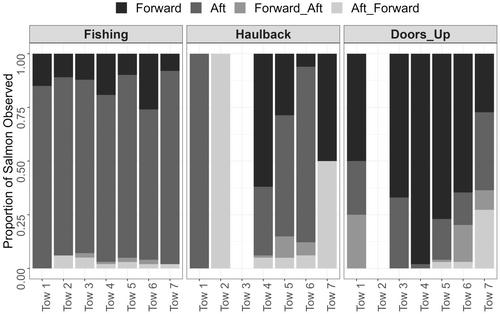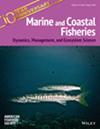Evaluating Pacific salmon swimming behavior in the aft end of a pelagic trawl to inform bycatch reduction device design and use
Abstract
Objective
Although the bycatch of Pacific salmon Oncorhynchus spp. is relatively low in the Walleye Pollock Gadus chalcogrammus and Pacific Hake Merluccius productus pelagic trawl fisheries, different efforts are employed to reduce it, including the use of bycatch reduction devices (BRDs) that retain the targeted species and provide Pacific salmon a pathway to escape. The objective of this study was to evaluate Pacific salmon behavior inside a pelagic trawl and to determine what conditions favor the probability of a salmon moving forward in the trawl and increase their probability of escapement.
Methods
We placed a video camera at the entrance of the cod end and recorded the behaviors of Pacific salmon as they passed by. The timing of the forward movement Pacific salmon in relation to fishing operations and the correlations between forward movement of Pacific salmon and vessel speed over ground, water flow rate, ambient light levels, and abundance of Walleye Pollock were examined.
Result
Of the 2969 Pacific salmon observed, 71% were moving aft toward the cod end, 24% were observed moving forward, and 5% were moving aft then forward or forward then aft. The percentage (77%) and rate (0.86 fish per minute) of forward-moving Pacific salmon was greatest once the trawl doors were back on the vessel and water flow within the trawl was reduced. Speed over ground and Walleye Pollock abundance were negatively correlated with forward movement of Pacific salmon. Only 6.5% of Pacific salmon that were in the cod end when fishing ended were able to move forward before the cod end was on the vessel.
Conclusion
Pacific salmon can move forward in the trawl throughout fishing operations and haulback, but the percentage increases as the speed over ground and water flow inside the trawl is reduced. The low percentage of Pacific salmon that move forward after fishing has ended suggests that Pacific salmon escapement at the end of a tow is relatively low and suggests that BRD design should focus on stimulating escapement at the first BRD encounter.


 求助内容:
求助内容: 应助结果提醒方式:
应助结果提醒方式:


